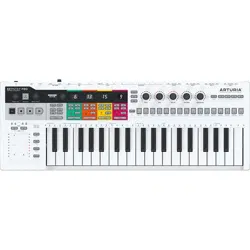Loading ...
Loading ...
Loading ...

5.5.2.1. Memorizing a Chord
Memorizing a chord is very easy: just hold down a chord, then hold down 'Shift' and quickly
press the Tie/Rest/Chord button. After this, as long as you keep holding down either 'Shift'
or Tie/Rest/Chord, you can add notes to the chord. When you let go of both Tie/Rest/Chord
and 'Shift', the KeyStep Pro will switch into Chord mode and the Tie/Rest/Chord button will
flash once per second. The next single key you press will play the chord you created in the
currently active scale.
The first note you entered will be the center key for transposition. Pressing any key above
that will transpose the chord up; pressing any key below it will transpose the chord down.
When you input notes in Chord Mode the KeyStep Pro will remember the intervals you play
and the order in which you play these intervals. If you play C, E, G, Chord Mode will register
the intervals starting at the first note: +4, +3.
So when you press a D in Chord mode the stored intervals will be recalled and the resulting
chord is D, (+4)=F#, (+3)=A.
When you create the same chord in a different order by first playing the E, followed by C
and G, the KeyStep Pro will store other intervals: -4, +7. When now you press a D in Chord
mode, the stored intervals will be recalled and the resulting chord is D, (-4)=Bb, (+7)=F.
Chord Mode recreates the intervals intelligently, if you select another scale, the intervals will
be recreated using notes allowed in that scale.
To summarize: the order in which you input notes will determine how chord mode will
recreate your chord. Notes you input are remembered as a string of intervals and recreated
in the currently active scale.
Here are a few more things to know about Chord Mode:
• You can use a sustain pedal instead of the Tie/Rest/Chord button for all Chord
mode functions. (The pedal will not flash, of course, but that would be cool!)
• Chord mode is a keyboard and Arpeggiator feature; it doesn't work when playing
a sequence. If Chord mode is active and you record a sequence hoping that the
sequence will play the chords, you'll be cruelly disappointed. However, you can
have a sequence playing and play the keyboard in Chord mode on top of it
• Chord mode can be initiated on all tracks when playing the keys, except on Track
1 when Drum mode is selected.
• You can memorize one chord per track
• Chords can be recorded in a sequence/pattern running in real-time mode.
This last feature requires a bit more explanation:
To record chords in the sequencer:
• Select a track (2, 3 or 4) and set it to Sequencer mode
• Select an empty pattern in this track
• Set Mode to Poly ('Shift'+ Poly)
• Press 'Shift' and Tie/Rest (Chord) and hold a chord on the keyboard.
Let go of 'Shift' and Tie/Rest, and check whether the chord has been registered by playing
keys on the keyboard. Now press Record + Play and play a few notes to record the chords
in the sequencer.
112 Arturia - User Manual Keystep Pro - Making Tracks
Loading ...
Loading ...
Loading ...
